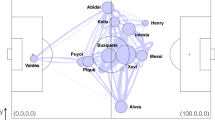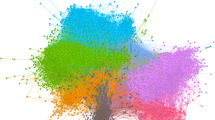Abstract
This paper analyzes the network of passes among the players of the Spanish team during the last FIFA World Cup 2010, where they emerged as the champion, with the objective of explaining the results obtained from the behavior at the complex network level. The team is considered a network with players as nodes and passes as (directed) edges. A temporal analysis of the resulting passes network is also done, looking at the number of passes, length of the chain of passes, and to network measures such as player centrality and clustering coefficient. Results of the last three matches (the decisive ones) indicate that the clustering coefficient of the pass network remains high, indicating the elaborate style of the Spanish team. The effectiveness of the opposing team in negating the Spanish game is reflected in the change of several network measures over time, most importantly in drops of the clustering coefficient and passing length/speed, as well as in their being able in removing the most talented players from the central positions of the network. Spain’s ability to restore their combinative game and move the focus of the game to offensive positions and talented players is shown to tilt the balance in favor of the Spanish team.
Similar content being viewed by others
References
Passos P, Davids K, Araújo D, Paz N, Minguéns J, and Mendes J, Networks as a novel tool for studying team ball sports as complex social systems, Journal of Science and Medicine in Sport, 2011, 14(2): 170-176.
Euro 2004 network predictions at Revista Redes (accessed January 2012), URL: http://revistaredes.rediris.es/webredes/eurocopa2004.htm, 2004.
Mendes R S, Malacarne L C, and Anteneodo C, Statistics of football dynamics, European Physical Journal B, 2007, 57(3): 357–363.
Brillinger D R, A potential function approach to the flow of play in soccer, Journal of Quantitative Analysis in Sports, 2007, 3(1): 3.
Hughes M and Franks I M, Notational Analysis of Sport: Systems for Better Coaching and PErformance in Sport, Routledge, New York, 2004.
Onody R N and De Castro P A, Complex network study of brazilian soccer players, Physical Review E, 2004, 70(3): 037103.
Yamamoto Y and Yokoyama K, Common and unique network dynamics in football games, PLoS ONE, 2011, 6(12): e29638.
Duch J, Waitzman J S, and Amaral L A N, Quantifying the performance of individual players in a team activity, PLoS ONE, 2010, 5(6): e10937.
Lee J, Borgatti S P, Molina J L, and Merelo Guervós J J, Who passes to whom: Analysis of optimal network structure in soccer matches, Poster at the Sunbelt XXV conference, URL: http://revistaredes.rediris.es/webredes/novedades/soccersunbelt.pdf, 2005.
Heuer A and Rubner O, Fitness, chance, and myths: An objective view on soccer results, The European Physical Journal B — Condensed Matter and Complex Systems, 2009, 67: 445–458.
Heuer A, Mueller c, and Rubner O, Soccer: Is scoring goals a predictable poissonian process? EPL (Europhysics Letters), 2010, 89: 38007.
Bundio J and Conde M, Análisis del desempeño deportivo durante la eurocopa 2004 a partir del análisis de redes sociales, REDES-Revista hispana para el análisis de redes sociales, 2009, 13(0) (in Spanish).
Simon H A, On a class of skew distribution functions, Biometrika, 1955, 42(3–4): 425–440.
Karbowski M R, Video-based social network analysis data collection in sport, QMSS2 2011 Workshop: Social Network Data Collection, URL: http://vladowiki.fmf.uni-lj.si/lib/exe/fetch.php?media=events:qmss2:abs:mariuszkarbowski.doc, 2011.
Dowie J, Why Spain should win the world cup, New Scientist, 1982, 94(10): 693–695.
Berrone P, Business lessons from the soccer world cup, Management Research: Journal of the Iberoamerican Academy of Management, 2011, 9(1): 73–78.
Holland P W and Leinhardt S, Transitivity in structural models of small groups, Comparative Group Studies, 1971, 2: 107–124.
Li X, Leonard D, and Loguinov D, On reshaping of clustering coefficients in degree-based topology generators, ed. by Leonardi S, Algorithms and Models for the Web-Graph (WAW 2004), volume 3243 of Lecture Notes in Computer Science, Springer-Verlag, Rome, Italy, 2004, 68–79.
Bonacich P, Factoring and weighting approaches to status scores and clique identification, Journal of Mathematical Sociology, 1972, 2: 113–120.
Erdős P and Rényi A, On the evolution of random graphs, Publications of the Mathematical Institute of the Hungarian Academy of Sciences, 1960, 5: 17–61.
Hughes M and Franks I M, Analysis of passing sequences, shots and goals in soccer, Journal of Sport Sciences, 2005, 23(5): 509–514.
BBC news piece: “World Cup 2010: Xabi Alonso slams Nigel De Jong tackle” (accessed May 2012), URL: http://news.bbc.co.uk/sport2/hi/football/worldcup2010/8813661.stm, July 13th, 2010.
Datablog: “World Cup 2010 statistics: Every match and every player in data” (accessed May 2012), URL: http://www.guardian.co.uk/news/datablog/2010/jul/09/world-cup-2010-statistics, July 9th, 2010.
Lago C and Martín R, Determinants of possession of the ball in soccer, Journal of Sports Sciences, 2007, 25(9): 969–974.
Bate R, Football chance: Tactics and strategy, Science and Football, 1988, 293–301.
Author information
Authors and Affiliations
Corresponding author
Additional information
This work has been supported in part by the CEI BioTIC GENIL (CEB09-0010) MICINN CEI Program (PYR-2010-13) project, the Andalusian Regional Government P08-TIC-03903, P08-TIC-03928, and TIC-6083 projects, and MICINN projects TIN2008-05941 and TIN2011-28627-C04.
This paper was recommended for publication by Editors FENG Dexing and HAN Jing.
Rights and permissions
About this article
Cite this article
Cotta, C., Mora, A.M., Merelo, J.J. et al. A network analysis of the 2010 FIFA world cup champion team play. J Syst Sci Complex 26, 21–42 (2013). https://doi.org/10.1007/s11424-013-2291-2
Received:
Published:
Issue Date:
DOI: https://doi.org/10.1007/s11424-013-2291-2




